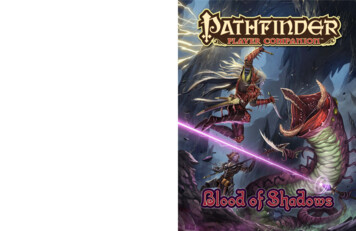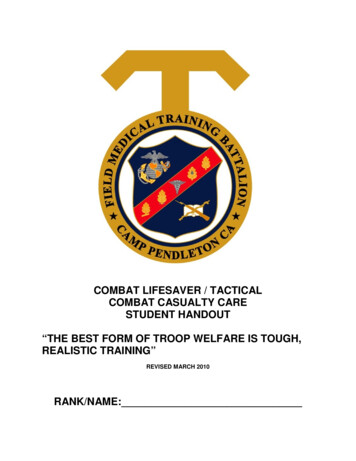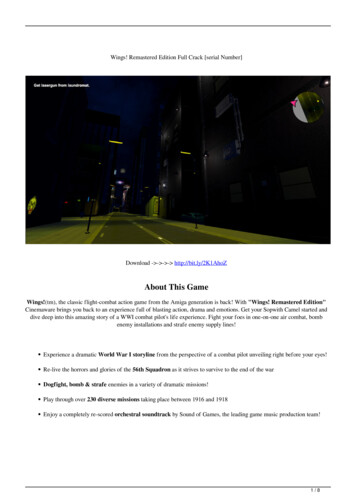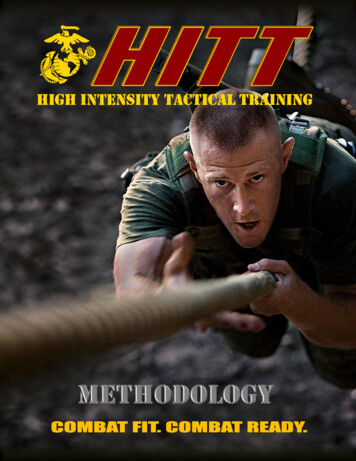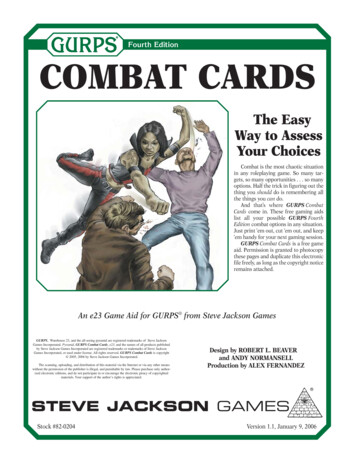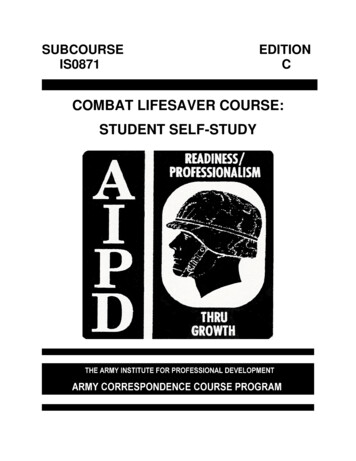
Transcription
SUBCOURSEIS0871EDITIONCCOMBAT LIFESAVER COURSE:STUDENT SELF-STUDY
ADMINISTRATIVE PROBLEMSQuestions of an administrative nature (such as missing pages in the subcourse booklet)should be addressed to your primary instructor (group leader). If you have questions ofan administrative nature after you have completed the course, you may write or call theArmy Institute for Professional Development (AIPD) at the following:Address:Army Institute for Professional DevelopmentATTN: ATIC-IPS (Student Services)U.S. Army Training Support CenterNewport News, VA 23628-0001Telephone: DSN 927-3335/3322Commercial (757) uestions about the content of this subcourse should be directed to your primaryinstructor (group leader). If you still have questions or comments concerning coursecontent, write or call the subject matter expert responsible for this edition of thesubcourse, Mr. Donald Parsons.Address:U.S. Army Medical Department Center and SchoolDepartment of Combat Medic TrainingATTN: MCCS-AW3151 W W White RoadFort Sam Houston, TX 78234-6100Telephone: DSN 471-5235Commercial (210) ICATION OF TRAINING LITERATURE TERMINOLOGYWhen used in this publication, words such as "he," "him," "his," and "men" are intendedto include both the masculine and feminine genders unless specifically stated otherwiseor when obvious in context.This subcourse is approved for resident and correspondence course instruction. Itreflects the current thought of the U.S. Army Medical Department Center and Schooland conforms to Department of the Army doctrine as closely as currently possible.Development and progress render such doctrine subject to change.The "C" edition of IS0871 is a major revision of the previous "B" edition. Copies ofedition “B” should no longer be used. This subcourse may be reproduced locally asneeded.IS0871i
COMBAT LIFESAVER COURSE: STUDENT SELF-STUDYINTERSCHOOL SUBCOURSE 0871U.S. Army Medical Department Center and SchoolFort Sam Houston, TexasGENERALInterschool Subcourse 0871, Combat Lifesaver Course: Student Self-Study, containsinformation needed to pass the written, written performance, and performanceexaminations for combat lifesaver certification and recertification. All of the taskscontain important, lifesaving information.Terminal objectives for this course are given below.TASK:Tactically manage a casualty.CONDITIONS: Given a casualty in a battlefield environment and a combat lifesavermedical equipment set.STANDARDS: Applied the procedures given in this course so that the mission isnot endangered and the risk of additional injury to the casualty isminimized.TASK:Evaluate and treat a casualty.CONDITIONS: Given a combat lifesaver medical equipment set and a casualty withone or more of the following problems: blocked airway, no respiration,bleeding from an extremity, amputation of an extremity, hypovolemicshock, or open chest wound.STANDARDS: Performed needed procedures in accordance with the proceduresgiven in this course and documented the treatment on a U.S. FieldMedical Card or Tactical Combat Casualty Care Card, as appropriate.TASK:Prepare and transmit a request for medical evacuation.CONDITIONS: Given a writing instrument, a MEDEVAC worksheet, neededinformation, and a transmitting device.STANDARDS: Prepared a MEDEVAC request in correct format and transmitted therequest following the rules for proper transmission.IS0871ii
TASK:Transport a casualty.CONDITIONS: Given a casualty in need of evacuation, drag equipment (such as aDragon Harness or SLICK litter), a SKED litter, a Talon litter, materialsfor improvising a litter (if used), and assistant(s) (if needed).STANDARDS: Prepared the SKED litter, Talon litter, improvised litter, or otherequipment (if used) and evacuated the casualty using a drag, manualcarry, or litter in accordance with the procedures given in thissubcourse.IS0871iii
TABLE OF CONTENTSPageGENERAL . .iiADMINISTRATIVE INSTRUCTIONS .vGRADING AND CERTIFICATION .viLesson 1INTRODUCTION TO THE COMBAT LIFESAVER ANDTACTICAL COMBAT CASUALTY CARE .Section I. The Role of the Combat Lifesaver .Section II. Tactical Combat Casualty Care .Exercises .1-11-11-21-9Lesson 2CARE UNDER FIRE .Exercises .2-12-9Lesson 3TACTICAL FIELD CARE .Exercises .3-13-17Lesson 4CONTROLLING BLEEDING .Section I. Controlling Bleeding Without a Tourniquet .Section II. Applying a Tourniquet .Exercises .4-14-14-104-22Lesson 5OPENING AND MANAGING A CASUALTY'S AIRWAY .Exercises .5-15-10Lesson 6TREATING PENETRATING CHEST TRAUMA .Section I. Treating an Open Chest Wound .Section II. Treating Tension Pneumothorax .Exercises .6-16-16-66-12Lesson 7INITIATING A FIELD MEDICAL CARD OR TCCC CARD .Section I. U.S. Field Medical Card .Section II. Tactical Combat Casualty Care Card .Exercises .7-17-27-147-19Lesson 8REQUESTING MEDICAL EVACUATION .Exercises .8-18-15Lesson 9TACTICAL CASUALTY MOVEMENT .Exercises .9-19-12Lesson 10EVACUATING A CASUALTY USING A LITTER .Exercises .10-110-12Appendix A COMBAT LIFESAVER MEDICAL EQUIPMENT SET .Appendix B HAWES CARRY .IS0871ivA-1B-1
ADMINISTRATIVE INSTRUCTIONSSUBCOURSE CONTENTThis subcourse contains ten lessons. Each lesson contains information needed tosuccessfully perform one or more tasks that a combat lifesaver is required to perform.SUPPLEMENTARY REQUIREMENTSMaterials Needed. You will be furnished with needed materials at the time you take theexaminations for this subcourse. Successful completion of the comprehensive written(multiple-choice) examination, written performance (Tactical Combat Casualty CareCard and MEDEVAC request) examinations, and all performance (hands-on)examinations is required for successful completion of the Combat Lifesaver Course.Supervisory Assistance. Study the information contained in this subcourse on yourown before attending classroom instruction. When you take the performance (handson) examinations, the evaluator will use checklists similar to those contained in thissubcourse. Each written performance examination will require you to complete a form.The comprehensive written examination will consist of multiple-choice items and will beclosed-book and proctored. Reference materials other than those provided by theevaluator will not be permitted.References. This subcourse contains all information needed to pass the written,written performance, and performance examinations. No supplementary references areneeded. However, references for additional study are given with the lessons.SUGGESTED STUDY PROCEDURESAfter reading and studying the text assignment of a lesson, complete the lessonexercises at the end of the lesson. If possible, answer the exercises without referringback to the lesson text. After completing the exercises, check your answers with theanswer key that follows the lesson exercises. For each exercise answered incorrectly,reread the subcourse material referenced and rework the exercise.If the lesson exercises contain a performance exercise, practice performing the task (ifpossible) and have someone check your actions against the performance checklist.When you take the actual performance examinations, an instructor will grade yourperformance using checklists similar to those contained in this subcourse. Keeppracticing until you can score a GO on all steps.The use of scenario training that allows the Combat Lifesaver student to perform in hisfull battle gear for performance testing is encouraged.Complete each lesson before proceeding to the next.IS0871v
GRADING AND CERTIFICATIONYou must score a minimum of 70 percent on the written (multiple-choice) examinationand score a GO on each written performance and performance examination in order topass this course. A NO-GO on any step of a performance checklist will result in a NOGO for the entire checklist.The written and written performance examinations will be proctored. You will not beallowed to use the subcourse or notes during the examination.The primary instructor (or a designated assistant) will be responsible for grading thewritten, written performance, and performance examinations. Please consult yourprimary instructor or his designated assistant for any questions concerning retaking afailed examination (written, written performance, or performance). An examination mayhave more than one version. If so, an alternate version may be used for retesting.A student who successfully completes the entire Combat Lifesaver Course (successfullycompletes all performance and written performance examinations and passes thecomprehensive written examination) will receive 40 credit hours from the Army Institutefor Professional Development (AIPD), Newport News, Virginia. There is no partialcredit. AIPD will send a notice of completion to the primary instructor for each studentwho successfully completes the entire Combat Lifesaver Course.IS0871vi
LESSON 1INTRODUCTION TO THE COMBAT LIFESAVER ANDTACTICAL COMBAT CASUALTY CARETASKTactically manage a simulated casualty.CONDITIONSGiven a written situation concerning tactical combat casualty care and possibleresponses.STANDARDSSelect the correct response based upon instruction given in Subcourse IS0871.REFERENCESSTP 21-1-SMCT, Soldier's Manual of Common Tasks: Skill Level 1.FM 4-25.11, First Aid.Prehospital Trauma Life Support Manual, sixth edition. Published by Mosby/Elsevier.Section I. THE ROLE OF THE COMBAT LIFESAVER1-1.ARMY BATTLE DOCTRINEThe Army battle doctrine was developed for a mobile and widely dispersedbattlefield. The doctrine recognizes that battlefield constraints will limit the ability oftrained medical personnel, including combat medics (Health Care Specialist, MOS68W), to provide immediate, far-forward care. Therefore, a plan was developed toprovide additional care to injured combat soldiers. The combat lifesaver is part of thatplan.1-2.PURPOSE OF THE COMBAT LIFESAVERa. The combat lifesaver is a bridge between the self-aid/buddy-aid (first aid)training given all soldiers during basic training and the medical training given to thecombat medic. The combat lifesaver is a nonmedical soldier who provides lifesavingmeasures as a secondary mission as his primary (combat) mission allows. The combatlifesaver may also assist the combat medic in providing care and preparing casualtiesfor evacuation when the combat lifesaver has no combat duties to perform.IS08711-1
b. Normally, one member of each squad, crew, or equivalent-sized unit will betrained as a combat lifesaver.c. A major advantage of the combat lifesaver is that he will probably be nearby ifa member of his squad or crew is injured. It may take a combat medic several minutesor longer to reach the casualty, especially if there are several other casualties and/orthe medic is at another location. The combat lifesaver is trained to provide immediatecare that can save a casualty's life, such as stopping severe bleeding and performingneedle chest decompression for a casualty with tension pneumothorax.1-3.COMBAT LIFESAVER'S AID BAGa. The combat lifesaver carries a small aid bag (called a medical equipment setor MES) containing supplies for controlling bleeding, relieving tension pneumothorax,and performing other procedures. A listing of the supplies found in the aid bag at thetime this subcourse was developed is given in Appendix A. For current information,check the U.S. Army Medical Materiel Agency (USAMMA) listing athttp://www.usamma.army.mil/ on the Internet under DOD Unit Assemblages.b. Some items must be replaced when their expiration date nears. Usually, thecombat lifesaver's unit will perform the needed stock rotation. If the combat lifesavermaintains his own bag, he must replenish his supplies in accordance with his unit'sstanding operating procedure (SOP).c. During combat, the combat lifesaver will need to be resupplied rapidly as hissupplies can be quickly depleted. The combat lifesaver can obtain additional suppliesfrom combat medics, from battalion aid stations or other nearby medical treatmentfacilities, and from ambulances evacuating casualties.Section II. TACTICAL COMBAT CASUALTY CARE1-4.BATTLEFIELD DEATHSAround 90 percent of combat deaths occur on the battlefield before thecasualties reach a medical treatment facility (MTF). Most of these deaths are inevitable(massive trauma, massive head injuries, and so forth). However, some conditions suchas bleeding from a wound on an arm or leg, tension pneumothorax, and airwayproblems can be treated on the battlefield. This treatment can be the differencebetween being a combat death on the battlefield and a recovering soldier in an MTF.It has been estimated that proper use of self-aid, buddy-aid, and combat lifesaver skillscan reduce battlefield deaths by 15 to 18 percent. Figure 1-1 gives a breakdown ofbattlefield deaths in the Viet Nam conflict. Figure 1-2 shows a breakdown ofpreventable deaths in Operation Iraqi Freedom (OIF) and Operation Enduring Freedom(OEF). Both figures indicate that extremity hemorrhage (severe bleeding from an armor leg), tension pneumothorax, and airway obstruction continue to be the primarypreventable causes of death in modern combat with extremity hemorrhage resulting inthe most deaths.IS08711-2
DEATHS DUE TO GROUND COMBAT31 percent--Penetrating head trauma.25 percent--Surgically uncorrectable torso trauma.10 percent--Potentially surgically correctable trauma.9 percent--Bleeding from wounds on the extremity.7 percent--Mutilating blast trauma.5 percent--Tension pneumothorax.1 percent--Airway problems.Less than 5 percent--Died of wounds (DOW) after evacuationto an MTF, mostly from infections andcomplications of shock.NOTE:Numbers do not add up to 100 percent. Not all causes of death are listed.Some deaths are due to multiple causes.Figure 1-1. Breakdown of battlefield deaths (Viet Nam).Figure 1-2. Primary injury site as a cause of death in the potentiallypreventable deaths (OIF/OEF).IS08711-3
1-5.PHASES OF TACTICAL COMBAT CASUALTY CARETactical combat casualty care (TCCC) can be divided into three phases. Thefirst is care under fire, the second is tactical field care, and the third is tacticalevacuation care.a. Care Under Fire. In care under fire, you are under hostile fire and are verylimited as to the care you can provide. Treatment consists primarily of using atourniquet to stop life threatening bleeding from wounds on the extremities and movingthe casualty to safety (see Lesson 2).Remember, in combat, functioning as a combat lifesaver isyour secondary mission. Your combat duties remain yourprimary mission. Your first priority while under fire is to returnfire and kill the enemy. You should render care to injuredsoldiers only when such care does not endanger your primarymission.b. Tactical Field Care. In tactical field care, you and the casualty are not undereffective enemy fire and you are free to provide casualty care to the best of your ability.However, the tactical situation can change and you could find yourself back in a careunder-fire situation.(1) Tactical field care may be rendered by the combat lifesaver after thecasualty has been moved to a safe location or when enemy fire has been suppressed(see Lesson 2).(2) Tactical field care also refers to care rendered by the combat lifesaverwhen the casualty is discovered in a tactical field care situation. That is, the casualtywas not in a care-under-fire situation to begin with (see Lesson 3).(3) In tactical field care, available medical equipment and supplies arelimited to that carried into the field by the combat lifesaver and individual soldiers.c. Tactical Evacuation Care. In tactical evacuation care, the care is renderedwhile the casualty is being evacuated to a collection point or medical treatment facility(see Lesson 10).(1) Casualty evacuation (CASEVAC) refers to the movement of casualtiesusing nonmedical vehicles or aircraft. In CASEVAC, the combat lifesaver may travelwith the casualty to provide care during transportation.(2) Medical evacuation (MEDEVAC) refers to evacuating casualties usingmedical ground ambulances or medical air ambulances. Medical evacuation vehicles(ground and air) have medical personnel to care for casualties during evacuation.IS08711-4
1-6.TERMINOLOGYAs you go through this subcourse, it will be helpful to know the meaning ofcertain terms. It is also recommended that you consult a medical dictionary forunfamiliar terms.a. Casualty. The casualty is the soldier who is injured.b. Rescuer. The term rescuer refers to another soldier who is attempting to aidthe casualty (provide treatment and/or move the casualty to safety).c. Self-Aid. Self-aid is the care (treatment) that the casualty gives to himself.(Care given by another soldier is buddy-aid. Care given by medical personnel such asa combat medic is medical aid.)d. Medical Treatment Facility. A medical treatment facility (MTF) is a facilityestablished to provide medical and/or dental care. In combat, the battalion aid station(BAS) is a mobile medical treatment facility close to the front lines.e. Collection Point. A collection point is a site to which combat casualties aredelivered, usually by nonmedical means (CASEVAC). There, the casualties aretransferred to medical vehicles (ground or air ambulances) and transported to an MTF(MEDEVAC).f. Extremity. The term extremity refers to one of the limbs.(1) Upper extremity. Upper extremity refers to the arm (located between theshoulder and the elbow) and the forearm (located between the elbow and the wrist).Often, the term "arm" is used to refer to the arm, forearm, and hand. The terms "upperarm" and "lower arm" are sometimes used to refer to the arm and forearm respectively.(2) Lower extremity. Lower extremity refers to the thigh (located betweenthe hip and the knee) and the leg (located between the knee and the ankle). Often, theterm "leg" is used to refer to the thigh, leg, and foot. The terms "upper leg" and "lowerleg" are sometimes used to refer to the thigh and leg respectively.g. Hemorrhage. Hemorrhage is another word for bleeding. It usually refers toserious bleeding.h. Dressing. The term "dressing" refers to the material that is placed directlyover the wound. The dressing absorbs some of the blood and helps a clot to form. Theclot "plugs" the wound to stop the bleeding. The dressing also protects the wound fromadditional contamination and injury.IS08711-5
i. Bandage. A bandage is the material used to hold (secure) the dressing inplace so the dressing will not slip and destroy the clot that is forming. The ends of thebandage are called the tails.j. Field Dressing. The field dressing consists of a pad of sterile (germ-free)white dressing with a bandage (usually olive drab) already attached to the dressing pad(see figure 1-3). The field dressing is wrapped in paper which is then sealed in a plasticenvelope. The field dressing is also called the field first aid dressing and the combatdressing. It is being replaced by the Emergency Bandage, but may still be encountered.Figure 1-3. Field dressing.k. Emergency Bandage. The Emergency Bandage (figure 1-4) consists of asterile white pad with an elastic tail and a pressure device used to apply continuouspressure to the wound. This bandage is also known as the "emergency traumadressing," "emergency trauma bandage," "Israeli pressure dressing," and "Israelibandage." It is replacing the field dressing in the soldier's individual first aid kit. Eachsoldier should have an Emergency Bandage in his Improved First Aid Kit (IFAK). Youhave two Emergency Bandages in your combat lifesaver aid bag.Figure 1-4. Emergency Bandage in its pouch.IS08711-6
l. Combat Gauze. Combat Gauze (figure 1-5) is also called the hemostaticbandage. It uses pressure and a chemical to help stop the bleeding. It is a componentof the soldier's Improved First Aid Kit (IFAK). You have three Combat Gauze bandagesin your combat lifesaver aid bag.NOTE:A hemostatic agent is an agent that arrests the flow of blood.Figure 1-5. Combat Gauze.m. Tourniquet. A tourniquet is a device for compressing the blood vessels of anextremity in order to stop blood flow distal to the tourniquet band.n. Combat Application Tourniquet. The Combat Application Tourniquet (CAT) is a device developed specifically to be used as a tourniquet. See figure 1-6. Itis a component of the soldier's Improved First Aid Kit (IFAK). You have two in yourcombat lifesaver aid bag.Figure 1-6. Example of a Combat Application Tourniquet.IS08711-7
o. Combat Casualty Pill Pack. Each soldier may be issued a combat pill pack(see figure 1-7) containing pain medications and antibiotics to control infection prior todeployment on tactical missions.Figure 1-7. Combat pill pack.p. Improved First Aid Kit. The Improved First Aid Kit (IFAK) is the first aid kitcarried by individual soldiers. Normally, the kit contains a Combat ApplicationTourniquet, an Emergency Bandage, Combat Gauze, a nasopharyngeal airway, a roll of2-inch tape, and two pairs of examination gloves.q. Combat Lifesaver Medical Equipment Set. The combat lifesaver medicalequipment set (MES) is also called the combat lifesaver aid bag. It is carried by thecombat lifesaver in combat. The contents of the MES are given in Appendix A.r. Distal. Distal means away from the point of reference. In this lesson, theheart is the central point of reference. The hand is distal to the elbow because the handis farther from the heart than is the elbow. (Follow the path of blood flow from the heartthrough the arteries as a guideline.) It is the opposite of proximal.s. Proximal. Proximal means toward the point of reference (heart). The knee isproximal to the foot because the knee is closer to the heart (following blood flow) than isthe foot. It is the opposite of distal.t Artery. Arteries are blood vessels that carry blood away from the heart to theparts of the body.u. Vein. Veins are blood vessels that carry blood from the parts of the bodyback to the heart.IS08711-8
EXERCISES: LESSON 1INSTRUCTIONS: Answer the following exercises by marking the letter of the responsethat best answers the question or best completes the sentence or by writing the answerin the space provided.After you have answered all of the exercises, check your answers against the"Solutions to Lesson Exercises" at the end of the exercises. For each exerciseanswered incorrectly, reread the lesson material referenced.1.Of the deaths that occur during ground combat, about what percent die beforereaching a medical treatment facility?a.b.c.d.2.10 percent.50 percent.75 percent.90 percent.Your unit is in ground combat. You see a soldier fall as though he has been shot.Your primary duty is to:a. Continue firing at the enemy.b. Stop firing and go to the fallen soldier.3.You are treating a casualty while under fire. Which of the following can youperform before moving the casualty to a place of safety?a.b.c.d.e.4.Perform cardiopulmonary resuscitation (CPR).Apply a tourniquet to control severe bleeding on a limb.Perform needle chest decompression to relieve tension pneumothorax.Administer the combat pill pack to control pain and infection.None of the above.Tactical combat casualty care has three phases. List the phases.a.b.c.IS08711-9
5.A casualty is being transported to a collection point using a nonmedical vehicle.Which of the following terms apply?a. CASEVAC.b. MEDEVAC.6.What medical term means bleeding, usually severe?7.A pad of material placed on the wound to absorb the blood is called thewhile the material used to keep the pad fromslipping off the wound is called the .8.The wrist is to the elbow. The elbow is to the wrist.a. Distal; proximal.b. Proximal; distal.9.Is the combat lifesaver considered to be a medical soldier?a. Yes.b. No.10,What are the three most common medically preventable causes of death on themodern battlefield?IS08711-10
11.Of the three preventable causes of death in exercise 10, which results in the mostdeaths?Check your answers on the next page.IS08711-11
SOLUTIONS TO EXERCISES: LESSON 11.d(para 1-4)2.a(paras 1-2a, 1-5a box)3.b(para 1-5a)4.a. Care under fire.b. Tactical field care.c. Tactical evacuation care.5.a6.Hemorrhage7.Dressing; bandage8.a(paras 1-6r, s)9.b(para 1-2a)(paras 1-5a, b, c)(para 1-5c(1))(para 1-6g)(paras 1-6h, i)10.Extremity hemorrhage (severe bleeding from an arm or leg).Tension pneumothorax.Airway obstruction. (para 1-4, fig 1-1)11.Extremity hemorrhage (severe bleeding from an arm or leg).IS08711-12(para 1-4, fig 1-1)
LESSON 2CARE UNDER FIRETASKTactically manage a simulated casualty in a care under fire situation.CONDITIONSGiven a written situation concerning a casualty under combat conditions and possibleresponses.STANDARDSSelect the correct response based upon instruction given in Subcourse IS0871.REFERENCESSTP 21-1-SMCT, Soldier's Manual of Common Tasks: Skill Level 1.FM 4-25.11, First Aid.Prehospital Trauma Life Support Manual, sixth edition. Published by Mosby/Elsevier.2-1.INTRODUCTIONCare under fire is the first phase of tactical combat casualty care. In care underfire, you and the casualty are under hostile fire and you are very limited to the care youcan provide. In fact, you may not be able to provide any care. Your combat dutiesremain your primary mission. Your first priority while under fire is to return fire. Youshould render care to injured soldiers only when such care does not endanger yourprimary (combat) mission.2-2.ACTIONS UNDER FIREWhen you are under effective hostile fire and see a wounded soldier who is alsounder enemy fire, you should do the following.a. Take cover and return fire.b. Suppress enemy fire. Reducing enemy fire may be more important to thecasualty's survival than any immediate treatment you can provide.c. Try to keep the casualty from sustaining any additional wounds.IS08712-1
d. Direct or expect the casualty to remain engaged as a combatant.e. Try to determine if the casualty is alive.f. If the casualty can function, direct him to move to cover, return fire, andadminister self-aid.g. If the soldier has suffered an amputation or has serious bleeding from anextremity, direct him to apply the Combat Application Tourniquet from his Improved FirstAid Kit (IFAK) over his uniform and above the wound.h. If the casualty is unable to return fire or move to safety and you cannot assisthim, tell the casualty to “play dead.”i. Communicate the situation to your unit leader.2-3.ACTIONS BEFORE APPROACHING THE CASUALTYIf you determine that you can provide assistance to the casualty under enemyfire, take the following actions before approaching a casualty on the battlefield.Remember to protect yourself.a. Scan the area for potential danger.(1)Survey the area for small arms fire.(2)Survey the area for fire or explosive devices.(3)Determine threat for chemical or biological agents.(4)Survey buildings, if any, for structural stability.b. Determine the best route of access to the casualty and the best route ofegress. If you need to move the casualty to a safer area, be sure to select an area thatprovides optimum cover and concealment. Plan your evacuation route prior to exposingyourself to possible hostile fire.c. Request covering fire during movement to and from the casualty's location toreduce the risk to yourself and the casualty.d. Anticipate the type of injuries the casualty may have received and what carewill probably be needed. Did the casualty fall from a wall? (If so, the casualty may havebroken bones.) Was there an explosion? (If so, the casualty may have blast effects.)Was there small arms fire? (If so, the casualty may have bleeding wounds.)IS08712-2
e. Anticipate how your actions (movement, noise, light, and so forth) may affectthe enemy's fire.f. Decide what care you can administer when you reach the casualty and whatcare will have to wait until you have moved the casualty to a place of safety.2-4.PROVIDING CARE UNDER FIREIf the casualty cannot move himself to a place of safety and the combat situationallows you to safely assist the casualty, quickly evaluate the casualty, control any lifethreatening bleeding from the extremities
STP 21-1-SMCT, Soldier's Manual of Common Tasks: Skill Level 1. FM 4-25.11, First Aid. Prehospital Trauma Life Support Manual, sixth edition. Published by Mosby/Elsevier. Section I. THE ROLE OF THE COMBAT LIFESAVER 1-1. ARMY BATTLE DOCTRINE The Army battle doctrine was
